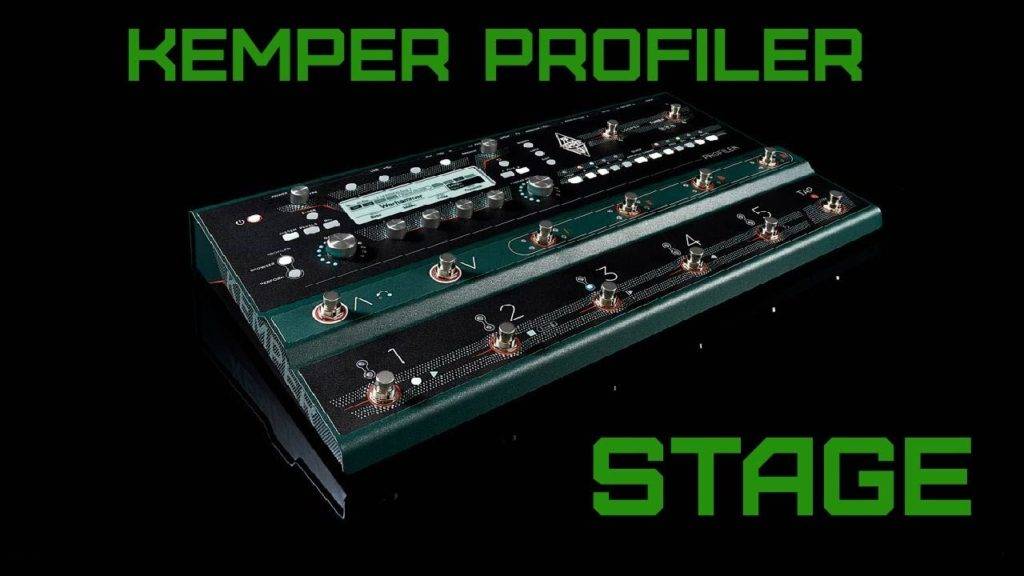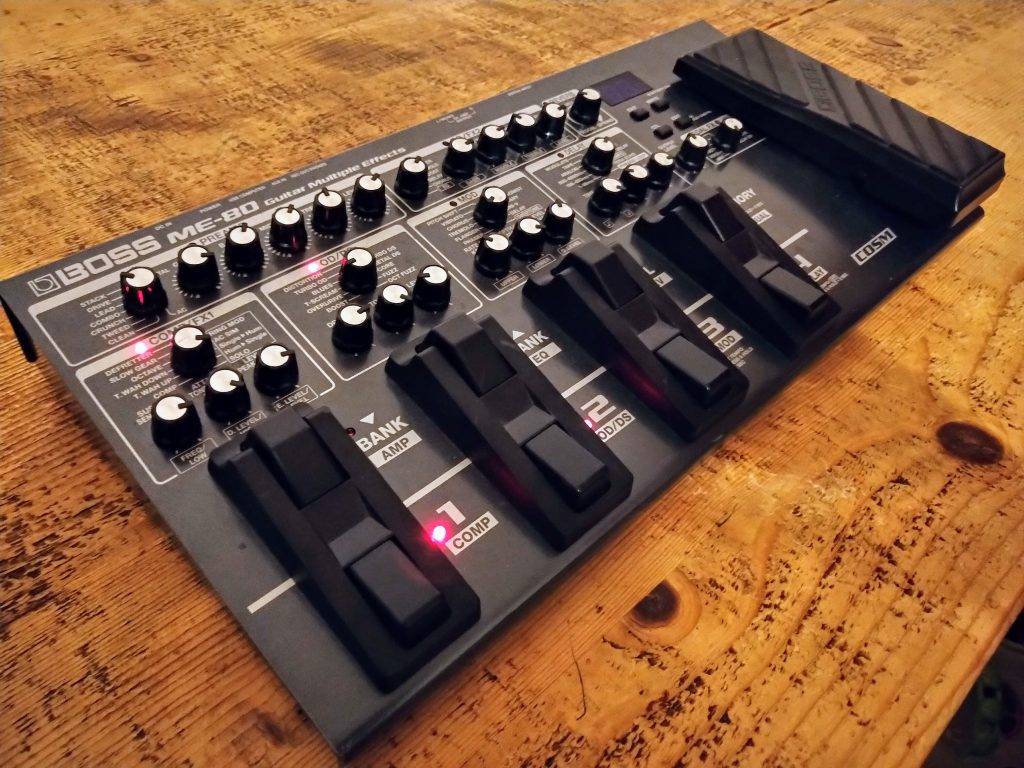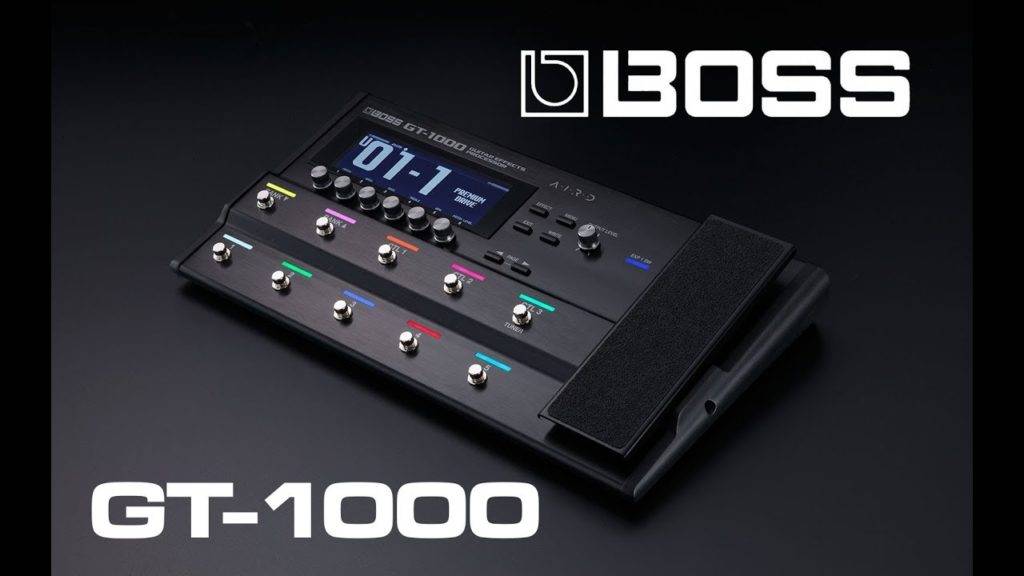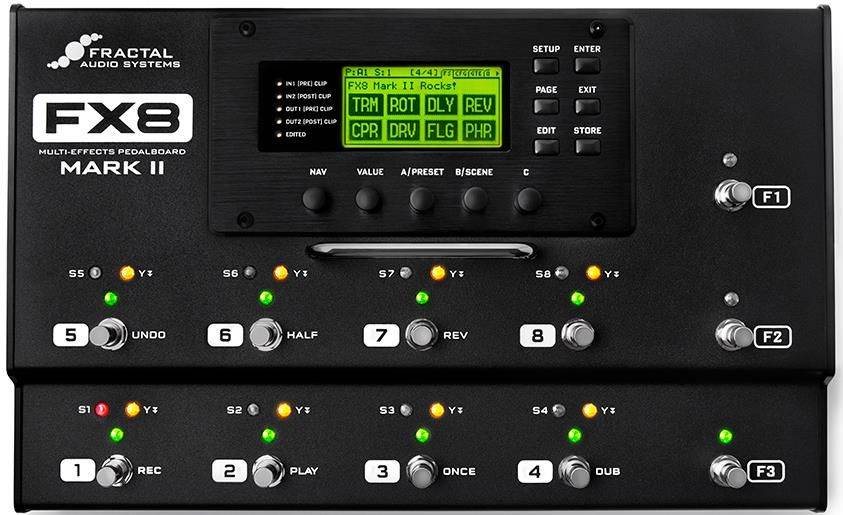Choosing the best guitar multi-fx processor out there is a constant battle of pros and cons. Online forums, reviews, and chat groups go back and forth with facts and opinions just like the never-ending, “Do you like Satriani or Vai better?” debate. Is it a matter of opinion, or fact?
The best guitar multi-fx processor is the processor that best fits the needs of the individual. Studio work is not the same as live performance, and hobbyists have entirely different needs than professionals.
I have noticed that there are many users out there who aren’t thoroughly savvy when it comes to their gear. Someone recently asked me how the stereo sound was on a 112 cabinet. That’s mono, not stereo. While displaying a complex 7-cable hookup of my Line 6 Helix through my Marshall stereo cabinet someone made a suggestion that was “an easier setup” which resulted in an unholy amount of squealing.
For me, the best gear has the best sound, the most features, the most user-friendly interface, and the best price.
Here’s a shootout of some of the top boards and how I rate them according to price, weight, durability, user-friendliness, versatility (features), and tonal quality.
Headrush Floorboard

This beast is made with a durable steel chassis and a gorgeous 7-inch touch screen display. Great features like spill-over effects between presets (similar to snapshots), a 20-minute looper, and hands-free editing make this a very useful board for live performance. Headrush sports 33 amps, 15 cabs, 10 mics, and 42 stomp effects. Its durability is further supported by its use of a standard AC power cable. An external expression pedal and ports for 1/4-inch, XLR, headphones, MIDI, and USB makes it pretty well-equipped for whatever you’re plugging into whether it’s an amp, PA, or computer.
Unfortunately, Headrush falls short with only one stereo loop built-in for use with whatever single pedal you choose to add to the seemingly short list of effects. 42 effects are great, but a shortlist when compared to the competing boards that follow in our shootout.
Summary:
- Price: $1000
- Weight: 15.7lbs
- Durability: Very sturdy!
- Versatility: Average.
- User-friendliness: Extremely nice with the large touchscreen.
- Tonal quality: Fantastic.
Kemper Floorboard

Kemper is one of the most talked-about boards on the market. The system is a little more than an effects processor, however. Kemper is a profiler which means it’s designed to capture and duplicate any tone that you fancy. With 100s of amps, what more could you want? The Kemper floorboard features a great tone and nearly infinite amp modeling.
The cons? The price, the screen, and the hardware features. While using a standard AC cable Adds to the sturdiness, having a strong board doesn’t outweigh the fewer ports and mere 4 stomp buttons. There are 2 stereo send/return loops which are one more than HeadRush. The standard expectations of 1/4-inch and XLR out are joined by MIDI and S/PDIF ports. The USB port, however, cannot be used as a USB interface. Its purpose is just for software and updates, but that’s all. No extension of this $1700 board. For that price, one can expect more than a dizzying barrage of buttons and knobs decorating mission control accompanied by a 1980s style monochromatic screen only a bit bigger than 2 Apple watches side by side.
- Price: $1700
- Weight: 10.4 pounds
- Durability: Medium.
- Versatility: Not very, needs more ports and floor control.
- User-friendliness: Very low!
- Tonal quality: Fantastic.
Boss ME-80

The ME-80 isn’t the champion of the Boss brand, but it’s still a huge favorite amongst players. I believe it’s because it’s laid out just like a regular pedalboard. This setup is visually great and requires no screen (while there is a small one just for channel numbers.) You use it like you would use most of your pedals, which is pretty easy. Knobs will always win over buttons, in my honest opinion. Because this is a Jr. to the big Boss GT-1000 I won’t compare it to the big boys with pros and cons. This is just a great board to consider on the low and so here are the stats as I see it for a board like this:
- Price: $300 (Great for a little powerhouse!)
- Weight: 8lbs (You could shove it in your gig bag if the pouch is big enough.)
- Durability: It’s built like a tank, but with a lot of knobs be careful not to bump any off.
- Versatility: This isn’t built to be versatile, it’s a basic board with basic ports. However, it’s the only effects processor on the list that has the option to go on stage on battery power!
- User-friendliness: Very easy to use.
- Tonal quality: Quite good!
Boss GT-1000

This is the big guy of the boss series. It’s ranked up in class with Headrush, Helix, and Kemper. But does it deliver? The GT-1000 (while named like a Terminator robot) has a huge screen, but it is monochromatic. Still, it’s very clear and nice and large. You can adjust the contrast to improve visibility for indoor and outdoor gigs. There are colors on the stomp buttons, and it boasts a high 116 effects to accompany about 12 amplifiers. That blows HeadRush and Kemper out of the water with options. There are 1/4-inch outputs, XLR, headphones, 2 effects loops, 2 expression pedal ports, MIDI and YES the GT-1000 will function as a USB interface, too.
Are there any cons? Well, a color screen would be nice for the price but the large screen is still clear. Somehow, unfortunately, BOSS missed the boat to the meeting which said, “tiny adapters aren’t that reliable.” This isn’t the only one on the list (aside from its junior edition above) that uses a small tip on the end of a very weak power supply. Don’t let this sucker break, bend, or fall out!
- Price: $1000
- Weight: 8lbs
- Durability: Very strong.
- Versatility: A good balance of effects and ports.
- User-friendliness: Not the best of the best in menus, but the big screen sure helps!
- Tonal quality: Great!
Fractal AX8

This beast is praised by its owners. A buddy of mine owns one and he’ll tell you it sounds great! With an amazing 222 amps, Fractal seems to be competing with Kemper. Like Kemper, Fractal boasts it’s amp modeling and a modest list of effects. Still, that’s more than Kemper! There’s no USB interface which is a downer. Still, they make up for it with plenty of ports. 2 XLR, 2 1/4-inch outputs, 2 effects loops, 4 pedal ports, MIDI, and S/PDIF.
For me, this board lacks user-friendliness. The tone is great, but the buttons are very generic. The monochromatic (green) screen is hideous, to say the least. The ports, while plentiful, are all mushed together making it hard to find any of them without actually looking directly at them. For those of us who have tried to set up in a dimly lit venue, this is not at all ideal for a live setting. Fractal might be best in the studio or for home use, but at $1400 is it worth it?
- Price: $1400
- Weight: 14lbs
- Durability: Medium; strong chassis, weak buttons.
- Versatility: A “meh”, no USB interface, and a horrible interface in general.
- User-friendliness: Take your Dramamine and hope for the best!
- Tonal quality: Very good.
Line 6 Helix

They say save the best for last, and I think Line 6 has laid out a template for brilliance here. The Line 6 Helix is powerful, durable, user-friendly, and sounds fantastic. The heavy steel chassis can be a lot to haul but you can bet it’ll hold up at any gig. I’ve had boards slide around when I step on them. Helix doesn’t budge. At all. The large full-color screen isn’t a touchscreen like on the HeadRush, but these two boards are the only two that thought about a nice large color interface. That’s a win. With 72 amps, 192 effects, 37 speakers, and 16 mics (all of which are expanding through firmware updates) Helix plenty of options to set up your tone any which way you dream of having it. Line 6 uses IRs which some boards out there are using, but not many yet. This feature makes Helix rival its more expensive competitor, Kemper. While the two boards aren’t really in the same class, they are often compared to each other. Helix has a whopping 12 capacitive foot-switches which are accompanied by digital (customizable) scribble strips so you’ll never forget what your stomp buttons are set up to do. What’s more, the stomp buttons can be used in an assortment of ways between stomp mode, snapshots, and selecting patches. The sky seems to be the limit! USB interface? Check. Effects chains? 4 of them! Control center allows for easy access to MIDI control and amp channel control (and more.) Hardware? A sturdy AC power cable, 2 expression pedal ports, amp control, voltage control, guitar input, aux input, mic input, 2 XLR ports, 2 1/4-inch outputs, headphones, Variax port, MIDI, S/PDIF, Line 6 link (AES/EBU), … and a partridge in a pear… well, not that.
Are there any cons? Well, it doesn’t come with the IRs, you have to install them yourself. It doesn’t have a touch screen to rival HeadRush. The board ain’t cheap, but it ain’t as expensive as Kemper! Honestly, there aren’t any downsides, this is a fantastic board. Does it sound great? Sure does.
- Price: $1700
- Weight: 15lbs
- Durability: Think “tank”.
- Versatility: I’ve used it as a PA for small gigs. It’s versatile.
- User-friendliness: Amazingly easy to use, with or without software.
- Tonal quality: Fantastic.
One more thing…
Helix is the only one on the list that has a whole family of products. If you want a lighter version, there’s the LT. If you want all of the effects but need only your amp there’s the HX Effects. If you love all of it but want a tiny version to sit in with your pedals… there’s the HX Stomp.
So who’s the victor in our shootout? Without a doubt, Line 6 Helix. If the options aren’t enough on the Helix itself, the multiple models available just open more doors for everyone. You can use it to practice, record, perform… hobbyists and professionals can enjoy it. HeadRush runs a close second, and Fractal and Kemper are there ready to deliver in tone with their not-so-gorgeous interfaces. The Boss GT-1000 ties the rest for third place. All in all, these boards are all pretty great if you’re a hobbyist or just noodling in the studio. However, for live players and pros out there we’re looking for the total package. I think Helix offers enough to satisfy any kind of player.
What do you think?
Leave a Reply